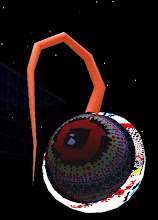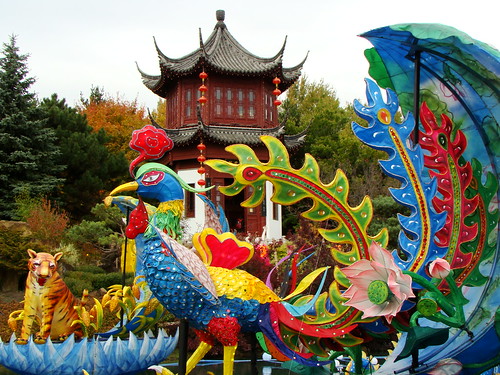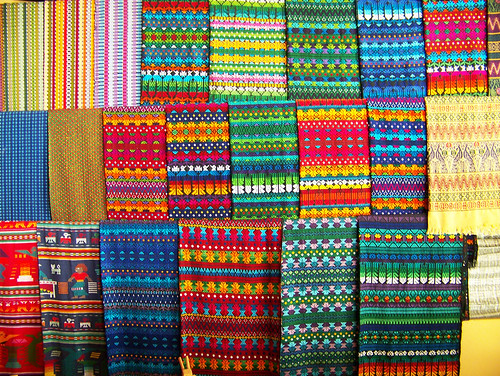.
. .
. . .
. . . .
. . . . .
. . . . . .
. . . . .
. . . .
. . .
. .
.
jueves, noviembre 19, 2009
Alejandro Jodorowsky - Tarot of Marseilles
miércoles, noviembre 18, 2009
Alejandro Jodorowsky
Jodorowsky began his artistic activities at a very young age, inspired greatly by film and literature. He began publishing his poetry in Chile when he was 16. At this time, he worked alongside the Chilean poets Nicanor Parra and Enrique Lihn. He developed an interest in puppetry and mime. He published his first book of poetry when he was 16. At 17, he debuted as an actor and a year later he created the pantomime troupe, Teatro Mímico. In 1953, Jodorowsky wrote his first play, El minotauro (The Minotaur). That same year he traveled to Paris to study pantomime with Etienne Decroux, the teacher of Marcel Marceau. The next year he joined Marcel Marceau theatre troupe; the performances realized during this collaboration toured worldwide. In 1955 he attended university in Santiago, Chile. After performing in Mexico in 1960, Jodorowsky decided to continue his stay in order to pursue other theatrical endeavors.
In February 1962, in Paris, Jodorowsky, along with Fernando Arrabal and Roland Topor, initiated the Panic Movement[1], an artistic movement centered around three basic elements: terror, humor, and simultaneity. These acts combine layers of physical postures inspired by the imagination and integrate artistic elements. Acts of this movement include Cuentos pánicos, Teatro pánico, Fabulas pánicas and Efímeros pánicos.
| Alejandro Jodorowsky | |
|---|---|
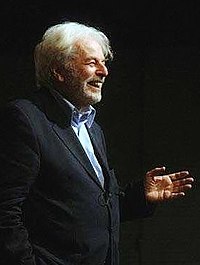 | |
| Born | February 7, 1929 (1929-02-07) (age 80) |
| Spouse(s) | Valerie Jodorowsky |
Throughout the 60s and 70s, working in Paris and Mexico, Jodorowsky created over one hundred theatrical productions. He directed works of his own in addition to those written by Leonora Carrington, Samuel Beckett, Eugen Ionesco, August Strindberg and others. El acto efímero (or "ephemeral performances") was acted out in public spaces, drawing attention to the quotidian while promoting critical awareness in both participants and audience. During these ephemeral acts the public is often unaware that an act of drama is being performed. Jodorowsky once stated: "the panic man is not, he is ever becoming" to reference Alfred Korzybski's influence on his thought.
Beginning in 1966, Jodorowsky created comics relating to "El pánico." These comics were made independently and in collaboration with illustrators including Jean "Mœbius" Giraud. In the course of his comic career, Jodorowsky has created approximately 21 series including Fábulas pánicas, Los ojos del gato and El incal. All translated from Spanish into over ten languages.
Jodorowsky's first experience with movies was in 1957 in Paris, where he adapted Thomas Mann’s Las cabezas trocadas as La Cravate. He next created Fando y Lis in Mexico in 1967[1]. Two years later, Jodorowsky created his most renowned film, El Topo (aka The Mole). In the following years additional films were realized including The Holy Mountain in 1972.
Jodorowsky spent over fifteen years reconstructing the original form of the Tarot de Marseille. From this work he moved in to more therapeutic work in three areas: psychomagic, psychogenealogy and initiatic massage. Psychomagic aims to heal psychological wounds suffered in life. This therapy is based on the belief that the performance of certain acts can directly act upon the unconscious mind, releasing it from a series of traumas, some of which are passed down from generation to generation. Psychogenealogy includes the studying of the patient’s personality and family tree in order to best address their specific sources.
Jodorowsky has several books on his therapeutic methods, including Psicomagia: La trampa sagrada (Psychomagic: The Sacred Trap) and his autobiography La danza de la realidad (The Dance of Reality). To date he has published over 23 novels and philosophical treaties, along with dozens of articles and interviews. His books are widely read in Spanish and French, but are for the most part unknown to English-speaking audiences.
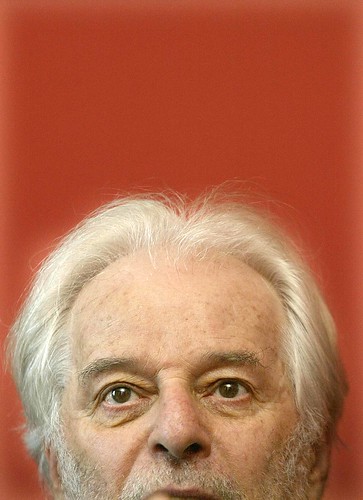
Alejandro Jodorowsky, inserito originariamente da bernacordon.
Throughout his career, Jodorowsky has gained a reputation as a philosopher and scholar who presents the teachings of religion, psychology and spiritual masters, by molding them into pragmatic and imaginative endeavors. All of his enterprises integrate an artistic approach. Currently Jodorowsky dedicates much of his time to lecturing about his work.
For a quarter of a century, Jodorowsky held classes and lectures for free, in cafés and universities all over the city of Paris. Typically, such courses or talks would begin on Wednesday evenings as tarot divination lessons, and would culminate in an hour long conference, also free, where at times hundreds of attendees would be treated to live demonstrations of a psychological "arbre généalogique" ("tree of genealogy") involving volunteers from the audience. In these conferences, Jodorowsky would pave the way to building a strong base of students of his philosophy, which deals with understanding the unconscious as the "over-self" which is comprised of many generations of family relatives, living or deceased, acting on our own psyche, well into our adult lives, and causing our compulsions. It is important to note that of all his work, Jodorowsky considers these activities to be the most important of his life. Though such activities only take place in the insular world of Parisian cafés, he has devoted thousands of hours of his life to teaching and helping people "become more conscious," as he puts it.
Presently, these talks have dwindled to once a month and take place at the "Librairie Les Cent Ciels" in Paris.
http://en.wikipedia.org/wiki/Alejandro_Jodorowsky
Alejandro Jodorowsky
Jodorowsky

Dona Magdalena: taught him initiatic/spiritual massage
La Tigresa: a famous Mexican Actress
Reyna D'Assia: the daughter of G.I. Gurdjieff, a spiritual leader
Maria Sabina: priestess of the sacred mushrooms
Pachita: a mystical healer
Violeta Parra: Chilean Singer
He started his film career in Mexico with Fando y Lis (1968). The feature-length film debuted in Acapulco at the Film Festival and is famous for having incited a full scale riot there, requiring that Jodorowsky be smuggled out in a limousine.
El Topo (1970), a mystical Western, was his second film and is now considered a cult classic. John Lennon and Yoko Ono helped to arrange the film's release and distribution in the United States through Beatles manager Allen Klein. It tells the story of El Topo, a Mexican gunslinger, in three main story arcs: (1) his revenge on a gang of bandits for their massacre of a small town's entire population; (2) his love for a woman, the woman's demands that El Topo take on four master gunmen who live in the desert, and El Topo's resulting fall from grace; and (3) El Topo's reawakening several years later in a colony of deformed people, his endeavor to release them from a mountain cave in which they are trapped, and his atonement.
Jodorowsky's third film, The Holy Mountain (La montaña sagrada) (1973), was entirely financed by John Lennon and Yoko Ono through the production office of Beatles producer Allen Klein. It has been suggested that The Holy Mountain may have been inspired by Rene Daumal's surrealist novel Mount Analogue. The Holy Mountain was another complex, multi-part story that featured a man credited as "The Thief" and equated with Jesus Christ, a mystical alchemist played by Jodorowsky, seven powerful business people representing seven of the planets (Venus and the six planets from Mars to Pluto), a religious training regimen of spiritual rebirth, and a quest to the top of a holy mountain for the secret of immortality. During the completion of The Holy Mountain, Jodorowsky received spiritual training from Oscar Ichazo of the Arica School, who encouraged him to take LSD and guided him through the subsequent psychedelic experience. Around the same time (2 November 1973), Jodorowsky participated in an isolation tank experiment conducted by John Lilly.
Shortly thereafter, Allen Klein demanded that Jodorowsky create a film adaptation of The Story of O, an erotic novel heavy on BDSM. Klein had promised this adaptation to various investors. Jodorowsky, who had discovered feminism during the filming of The Holy Mountain, refused to make the film, going so far as to leave the country to escape directing duties. In retaliation, Allen Klein made El Topo and The Holy Mountain, to which he held the rights, completely unavailable to the public for over 30 years. Jodorowsky frequently decried Klein's actions in interviews.
In December 1974, a French consortium led by Jean-Paul Gibon purchased the film rights to Dune from Arthur P. Jacobs. Jodorowsky was set to direct. In 1975, Jodorowsky planned to film the story as a ten hour feature, in collaboration with Salvador Dali, Orson Welles, Gloria Swanson, David Carradine, Geraldine Chaplin, Alain Delon, Hervé Villechaize and Mick Jagger. The music would be composed by Peter Gabriel. Jodorowsky set up a pre-production unit in Paris consisting of Chris Foss, a British artist who designed covers for science fiction periodicals, Jean Giraud (Moebius), a French illustrator who created and also wrote and drew for Metal Hurlant magazine, and H. R. Giger. Moebius began designing creatures and characters for the film, while Foss was brought in to design the film's space ships and hardware. Giger began designing the Harkonnen Castle based on Moebius' storyboards, and Dali was cast as the Emperor with a reported salary of $100,000 an hour. His son Brontis Jodorowsky was to play Paul. Dan O'Bannon was to head the special effects department.
Dali and Jodorowsky began quarreling over money, and just as the storyboards, designs, and script were finished, the financial backing dried up. Frank Herbert travelled to Europe in 1976 to find that $2 million of the $9.5 million budget had already been spent in pre-production, and that Jodorowsky's script would result in a 14-hour movie ("It was the size of a phonebook", Herbert later recalled). Jodorowsky took creative liberties with the source material, but Herbert said that he and Jodorowsky had an amicable relationship.
The rights for filming were sold once more, this time to Dino de Laurentiis. Although Jodorowsky was embittered by the experience, he stated that the Dune project changed his life.
After the collapse of the Dune project, Jodorowsky completely changed course and, in 1980, premiered his children's fable "Tusk", shot in India. Taken from Reginald Campbell's novel "Poo Lorn of the Elephants," the film explores the soul-mate relationship between a young British woman living in India and a highly prized elephant. The film exhibited little of the director's outlandish visual style and was never given wide release. Jodorowsky has since disowned the film.
In 1989, Jodorowsky completed Mexican-Italian production Santa sangre (Holy Blood). The film received limited theatrical distribution, putting Jodorowsky back on the cultural map despite its mixed critical reviews. Santa Sangre was a surrealist film with a plot similar to Alfred Hitchcock's Psycho. It featured a protagonist who, as a child, saw his mother lose both her arms, and as an adult let his own arms act as hers, and so was forced to commit murders at her whim. Several of Jodorowsky's sons were recruited as actors.
He followed in 1990 with a very different film, The Rainbow Thief. Though it gave Jodorowsky a chance to work with actual "movie stars" Peter O'Toole and Omar Sharif, the producer effectively curtailed most of Jodorowsky's artistic inclinations, threatening to fire him on the spot if anything in the script was changed.
In the 1990s and early 2000s, Jodorowsky attempted to make a sequel to El Topo, called at different times The Sons of El Topo and Abelcain, but could not find investors for the project.
In 2000, Jodorowsky won the Jack Smith Lifetime Achievement Award from the Chicago Underground Film Festival (CUFF). He attended the festival and his films were shown, including El Topo and The Holy Mountain, which at the time had grey legal status. According to festival director Bryan Wendorf, it was an open question of whether CUFF would be allowed to show both films, or whether the police would show up and shut the festival down.

jodorowsky, inserito originariamente da pompier.
Until 2007, Fando y Lis and Santa sangre were the only Jodorowsky's works available on DVD. Neither El Topo nor The Holy Mountain were available on videocassette or DVD in the United States or the United Kingdom, due to ownership disputes with distributor Allen Klein. After the dispute's settlement in 2004, however, plans to re-release Jodorowsky's films were announced by ABKCO Films. On January 19, 2007, the website announced that on May 1, 2007, Anchor Bay released a box set including El Topo, The Holy Mountain, and Fando y Lis. A limited edition of the set includes both the El Topo and The Holy Mountain soundtracks. And, in early February 2007, Tartan Video announced its May 14, 2007, release date for the UK PAL DVD editions of El Topo, The Holy Mountain and the 6-disc box set which, alongside with the aforementioned feature films, includes the 2 soundtrack CDs, as well as separate DVD editions of Jodorowsky's 1968 debut feature Fando y Lis (with his 1957 short La cravate aka Les têtes interverties, included as an extra) and the 1994 feature-length documentary La constellation Jodorowsky. Notably, Fando y Lis and La cravate were extensively digitally restored and remastered in London during late 2006, thus providing the perfect complement to the quality restoration work undertaken on El Topo and The Holy Mountain in the States by Abkco, and ensuring that the presentation of Fando y Lis is a significant improvement over the 2001 Fantoma DVD edition. Prior to the availability of these legitimate releases, only inferior quality, optically censored bootleg copies of both El Topo and The Holy Mountain have been circulated on the Internet and on DVD.
In an interview with Premiere Magazine, Jodorowsky said his next project will be a gangster film called King Shot. Marilyn Manson will play a 300-year-old pope, he said, and Nick Nolte has also expressed interest in working with the director. Both are also listed as executive producers for the film, which has a projected release date of 2009 . David Lynch is also rumored to be a producer. In the interview, Jodorowsky also said he wanted to make a sequel to El Topo, but couldn't raise the funds. In a recent interview by Viceland, he also indicated that financing for King Shot was proving to be difficult.
In an interview with The Guardian newspaper in November 2009, Jodorowsky revealed that he was unable to find the funds to make King Shot, and would instead be entering preparations on Son of El Topo, for which he claimed to have signed a contract with "some Russian producers".
The book Anarchy and Alchemy: The Films of Alejandro Jodorowsky is the first major English language study on the cinema of Jodorowsky.
Jodorowsky started his comic career in Mexico with the creation of Anibal 5 series in the mid 1966 with illustrations by Manuel Moro, and had his turn in drawing his own comic strip in the weekly series Fabulas pánicas that appeared in the Mexican newspaper El Heraldo de México. He also wrote original stories for at least two or three other comic books in Mexico during those days: Los insoportables Borbolla was one of them. After his fourth film, Tusk, he started The Incal, with Jean Giraud (Mœbius). This graphic novel has its roots deep in the tarot and its symbols, e.g., the protagonist of The Incal, John Difool, is linked to the Fool card. The Incal (which would branch off into a prequel and sequel) forms the first in a sequence of several science fiction comic book series, all set in the same space opera Jodoverse (or "Metabarons Universe") published by Humanoids Publishing.
Comic books set in this milieu are Incal (trilogy: Before the Incal/ Incal/ After the Incal), Metabarons (trilogy: Dayal de Castaka/ The Caste of the Metabarons/ The Dreamshifters) and The Technopriests and also a RPG adaptation, The Metabarons Roleplaying Game. Many ideas and concepts derived from Jodorowsky's planned adaptation of Dune (which he would have only loosely based upon Frank Herbert's original novel) are featured in this universe.
Mœbius and Jodorowsky sued Luc Besson, director of The Fifth Element, claiming that the 1997 film borrowed graphic and story elements from The Incal, but lost their case. The suit was plagued by ambiguity since Mœbius himself had willingly participated in the creation of the film, having been hired by Besson as a contributing artist, but had done so without gaining the approval of Incal co-creator Jodorowsky, whose services Besson did not call upon. For over a decade, Jodorowsky pressured his publisher Les Humanoïdes Associés to sue Luc Besson for the flagrant act of plagiarism, but the said publisher refused, rightfully fearing the inevitability of the final outcome. In a 2002 interview with the Danish comic book magazine Strip!, Jodorowsky actually claimed that he considered it an honour that somebody stole his ideas, which is not surprising, as Jodorowsky believes that authors do not create the stories they tell as much as they make personal interpretations of myths universal to the collective human subconsciousness. Privately, however, Jodorowsky has used harsh words in his retelling of how the plagiarizing of the Incal was supported by the courts, and often deplored the bias typically shown by French courts toward large industrial entities, to the detriment of comic book artists and writers. He has expressed great comfort, however, at the fact that anyone actually familiar with his creation has agreed that the work was obviously plagiarized by Besson.
Other action comics by Jodorowsky outside the genre of science fiction include the historically-based Bouncer illustrated by Francois Boucq, Juan Solo (Son of the Gun) and Le Lama blanc (The White Lama), both illustrated by Georges Bess.
Le Cœur couronné (The Crowned Heart, translated into English as The Madwoman of the Sacred Heart), a racy satire on religion set in contemporary times, won Jodorowsky and his collaborator, Jean Giraud, the 2001 Haxtur Award for Best Long Strip. He is currently working on a new graphic novel for the US market.
Jodorowsky's comic book work also appears in Taboo volume 4 (ed. Stephen Thrower), which features an interview with the director, designs for his version of Frank Herbert's Dune, comic storyboards for El Topo, and a collaboration with Moebius with the illustrated Eyes of the Cat.
He collaborated with Milo Manara in Borgia (2006), a graphic novel about the history of the House of Borgia.
http://www.clubcultura.com/clubliteratura/clubescritores/jodorowsky/index.htm
http://en.wikipedia.org/wiki/Alejandro_Jodorowsky
Jodorowsky
viernes, noviembre 06, 2009
The art of Light on Water- Chinese Lanternes de Chine
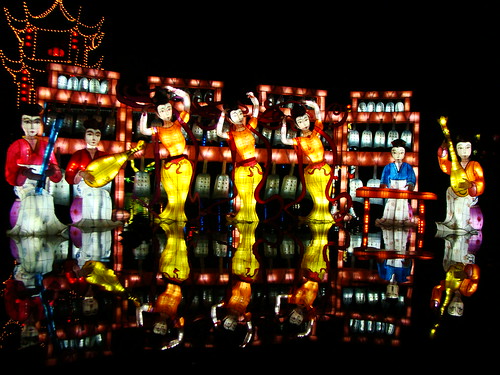
The art of Light on Water- Chinese Lanternes de Chine , inserito originariamente da herberouge1 somewhere over the rainbow.
The art of Light on Water- Chinese Lanternes de Chine
The art of Light on Water- Chinese Lanternes de Chine
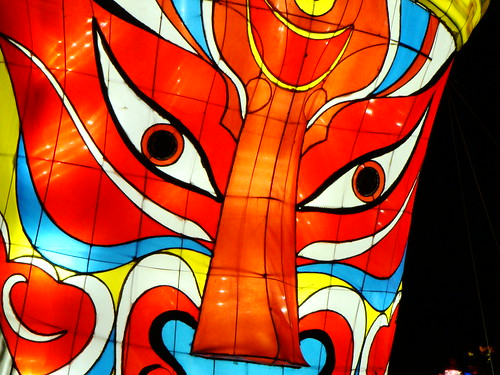
The art of Light on Water- Chinese Lanternes de Chine , inserito originariamente da herberouge1 somewhere over the rainbow.
The art of Light on Water- Chinese Lanternes de Chine
Sumidero Canyon - Cañón del Sumidero

This canyon is a result of a geological fault during the Pleistocene. The canyon is regarded as an important tourist attraction in the state of Chiapas. The importance and cultural symbolism of Sumidero Canyon for Chiapans are so great that its silhouette is the base of the Coat of Arms of the state of Chiapas.
The Sumidero Canyon is home to a great variety of wildlife including crocodiles.
El Cañón del Sumidero, es un orificio de gran profundidad situado a 5 km de Tuxtla Gutiérrez, capital del estado de Chiapas, México. Este cañón tiene un acantilado cuya altura va un poco más allá de los 1000 m del nivel del agua y se levanta sobre el cauce del río Grijalva, que tiene una profundidad de más de 300 m.
Río que atraviesa los estados de Chiapas y Tabasco y desemboca en el Golfo de México. En su boca sur, el cañón inicia en Chiapa de Corzo, y desemboca en el embalse artificial de la presa hidroeléctrica Manuel Moreno Torres, mejor conocida popularmente como "Chicoasén".
La relevancia del cañón del sumidero es tal que forma parte del Escudo de Chiapas.
Por su singular belleza y su importancia histórica, el ícono de Chiapas está nominado para una de las "Nuevas 7 Maravillas Naturales" como único representante de México en este concurso internacional.
La manera más habitual de llegar es en automóvil, autobús o pagando un recorrido guiado que puede incluir un recorrido en lancha y al ecoturístico que esta frente a la presa chicoasen. Se toma la carretera de Tuxtla Gutiérrez hasta los miradores del Cañón. También en el Museo de Antropología puede abordar un colectivo que lo lleve al mirador Los Chiapa. Si desea puede visitar el Parque Zoológico Miguel Álvarez del Toro (ZOOMAT), que le queda en el camino.
Otra alternativa es llegar en lancha, puede zarpar desde Cahuaré o Chiapa de Corzo.
Este cañón es producto de una separación de capas terrestres producto de una falla geológica durante el pleistoceno. Por sus dimensiones y vegetación tropical exuberante, este cañón es un importante atractivo turístico del estado de Chiapas.
Durante la conquista española de la región, la etnia Chiapa (o soctona, en su propio idioma) realizó un suicidio masivo al arrojarse desde la cumbre hacia el fondo del cañón para evitar quedar sometidos al conquistador -con ello creían, además, alcanzar la libertad en el inframundo. La importancia y simbolismo cultural de este cañón para los chiapanecos son tan grandes que su silueta es la base del escudo de armas del estado de Chiapas
http://en.wikipedia.org/wiki/Tuxtla_Guti%C3%A9rrez
http://en.wikipedia.org/wiki/Ca%C3%B1%C3%B3n_del_Sumidero
http://www.turismochiapas.gob.mx/canonsumidero.html
http://www.mapasmexico.net/googlemaps-canon-sumidero.html
Sumidero Canyon - Cañón del Sumidero


